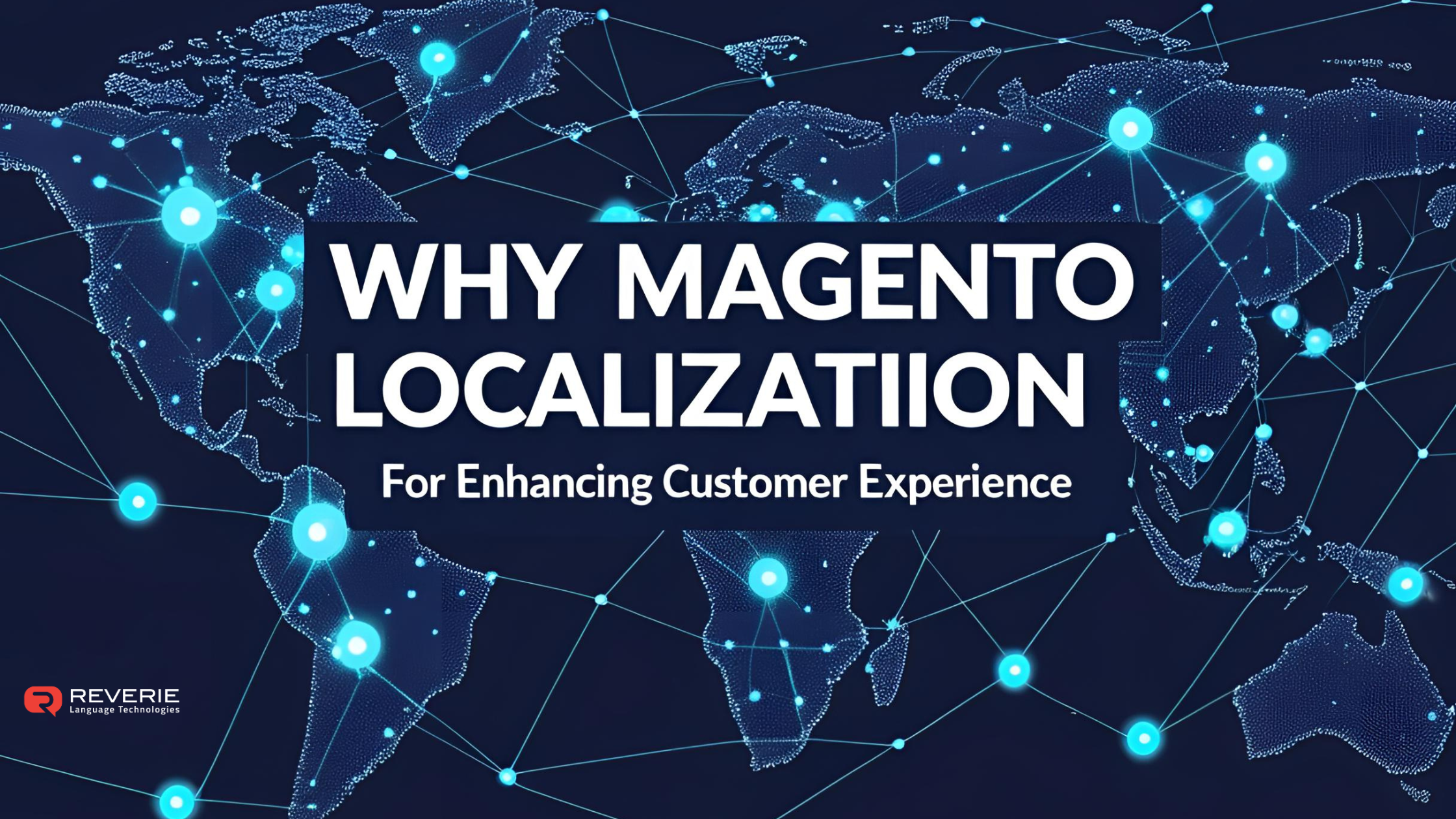Imagine walking into a store where everything from the product labels to the staff’s instructions is in a language you can’t read or understand. You’d likely feel disconnected, unsure of what to do next, and walk away without buying anything. That’s exactly what many online shoppers experience when they visit a website that hasn’t been localised.
For businesses running on Magento, this challenge also presents an opportunity to make every shopper feel seen, understood, and supported. Localising your store means more than just translating content. With Magento localisation, brands can build storefronts that feel familiar—reflecting each user’s language, region, and expectations. In a diverse and multilingual market like India, this kind of personalisation isn’t just appreciated, it’s expected by customers throughout every region.
What is Magento?
Magento is one of the world’s leading open-source e-commerce platforms, trusted by businesses to build flexible, scalable online stores. It allows brands to customise storefronts, manage multilingual content, and tailor checkout experiences for different markets, all from a single backend. With Adobe’s backing, Magento today combines enterprise-grade performance with the freedom to localise, helping businesses deliver more relevant, customer-first experiences across diverse markets.
Magento Meets the Market with Structured Localisation Capabilities
As Indian e-commerce businesses expand across linguistic and regional markets, Magento’s framework offers the right kind of structural flexibility to adapt.
Magento is well-regarded for its multi-store architecture, which allows businesses to build separate store views for different regions. This means you can customise product descriptions, categories, pricing, and checkout experiences independently, giving each market a localised storefront without affecting global operations.
For example, an Indian fashion retailer can run one storefront for Hindi-speaking users in Delhi and another for users in Tamil Nadu in Tamil, each with localised styling guides and promotions aligned with regional festivals.
Magento’s language pack system, a key part of its internationalisation (i18n) , simplifies how translations are managed across storefront elements.
You also have access to regional configurations—timezone settings, GST-specific Magento Meets the Market with Structured Localisation Capabilities
As Indian e-commerce businesses expand across linguistic and regional markets, Magento’s framework offers the right kind of structural flexibility to adapt.
Magento is well-regarded for its multi-store architecture, which allows businesses to build separate store views for different regions. This means you can customise product descriptions, categories, pricing, and checkout experiences independently, giving each market a localised storefront without affecting global operations.
For example, an Indian fashion retailer can run one storefront for Hindi-speaking users in Delhi and another for users in Tamil Nadu in Tamil, each with localised styling guides and promotions aligned with regional festivals.
Magento’s language pack system, a key part of its internationalisation (i18n) , simplifies how translations are managed across storefront elements.
You also have access to regional configurations—timezone settings, GST-specific tax setups, shipping rule customisation, and storefront visuals tailored by location.
What Localisation Actually Means for Magento Storefronts
Localisation for a Magento store goes well beyond swapping one language for another. It’s about shaping an experience that feels natural to the shopper—one that aligns with their expectations, preferences, and cultural habits.
In India, this might include:
- Structuring category hierarchies differently based on regional shopping behaviour (e.g., sarees prioritised over western wear in certain regions)
- Integrating hyperlocal delivery messaging, such as “Same-day delivery in Bangalore” or urgency-based prompts like “Order within 50 minutes for delivery in 2 days.”
- Using culturally appropriate imagery and language tones in banners, CTAs, and checkout confirmations
- Adapting customer support scripts and FAQs to offer responses in preferred local languages
These details make a real difference. When a shopper lands on a store that speaks their language and reflects their world, they feel more comfortable, more confident, and more ready to buy.
Why Customer Experience Improves When Stores Speak the Right Language
Localisation is a pivotal factor in delivering exceptional customer experiences. When shoppers interact with an e-commerce site in their native language, they are more likely to trust the brand and complete a purchase.
When users see content in their native language, they process information faster. When prices appear in their local currency, trust rises. And when checkout flows include their preferred payment methods, friction disappears.
Studies show that over 73% of users prefer shopping in their native language, and 40% are reluctant to buy from sites that don’t offer localised content. By providing product descriptions, customer support, and checkout processes in the customer’s language Magento stores can witness:
- Higher average time on site
- Lower cart abandonment
- Better conversion from organic search
- More meaningful brand engagement
Moreover, localisation extends beyond language. It includes adapting currency, payment methods, and even imagery to align with local preferences. For example, displaying prices in the local currency and offering region-specific payment options can significantly enhance the user experience, leading to increased customer satisfaction and loyalty.
Magento Localisation Challenges That Stall Scale
Localising a Magento store might seem straightforward at first, especially with built-in multi-store features. But once you start serving multiple languages, currencies, and customer journeys, the process often becomes messy, fragmented, and harder to sustain.
What starts as a few language toggles can quickly turn into a complex web of disconnected store views, inconsistent content updates, and overlooked SEO gaps.
Here’s where most businesses start to feel the pressure:
- Managing Too Many Storefronts at Once
Creating individual Magento store views for multiple languages gives you flexibility but also adds overhead fast. As soon as you are handling content for more than 3-4 regions, it’s easy to lose track.
- Every promotion needs to be recreated across languages, often manually
- Small updates like a product specification change require edits in five or six places
- Teams struggle to maintain consistency without overwriting or missing localised fields
- There’s often no centralised way to sync, preview, or QA changes across versions
- Disjointed SEO and Search Visibility
Localisation also affects how your store performs in search, but this area often goes under-managed.
- Localised keywords are skipped, or added without research into regional search trends
- Many Magento stores reuse English URL slugs and meta descriptions, losing organic visibility
- Lack of hreflang tags confuses search engines about which version to show
- Duplicate content risks increase when translations aren’t handled carefully
- Cultural Disconnect in Content and Visuals
A Magento store may be translated, but that doesn’t mean it feels local.
- Visual assets often remain designed for a global or Western audience
- Call-to-action language, button design, and even font choices may feel out of place
- Product usage examples don’t reflect Indian lifestyles
- Festival campaigns or banners lack regional context and fail to build an emotional connection
- Tech Limitations Slow Execution
Even with Magento’s robust architecture, localisation isn’t plug-and-play at scale.
- Most content management tasks require developer involvement, slowing down teams
- There’s no central dashboard to update, review, or schedule translations across views
- Testing every language version becomes a QA challenge in itself
- Integrating third-party translation tools often breaks or conflicts with custom themes
Best Practices for Magento Localisation That Actually Improve CX
Localisation often gets treated like a one-time project: translate the content, switch the currency, and move on. But stores that truly connect with their customers take a different route. They build localisation into the foundation of their customer experience, not just the frontend.
Magento gives you the framework, but how you localise it determines whether a visitor stays or bounces. Below are the approaches successful brands use to get localisation right.
- Focus on High-Impact Content First
Localisation can feel overwhelming when you look at your entire site at once. But not everything needs to be translated immediately. Start with the content that shapes buyer decisions, including your homepage banners, product titles and descriptions, CTAs, and checkout instructions.
For example, a regional electronics seller may prioritise translating product features into Hindi and Telugu for Tier 2 city audiences, while leaving blog content for a later phase. Focus where conversion happens.
Magento’s language packs will handle much of the interface language, but custom blocks, widget labels, and third-party extensions need manual attention. Connect to a localisation platform like Reverie’s Anuvadak, which helps manage, review, and sync content across multiple store views, without adding developer load or risking content mismatches.
- Build Region-Specific SEO from the Ground Up
Many Magento stores focus on translations but overlook how users search. If your product is labeled as a “refrigerator” when your local audience is typing “fridge” or “double door fridge in Hindi,” you will miss traffic.
- Build SEO strategies for each region like you would for different products.
- Use localised keywords in URLs, meta tags, and product slugs. Magento allows separate metadata per store view, use it.
- Also, implement hreflang tags correctly to help Google rank the right language version for the right region.
A smartphone brand selling across India might optimise the Hindi store view for “सस्ता स्मार्टफोन लंबे बैटरी बैकअप वाला”, while the English version uses “budget smartphones with long battery life.
- Adapt Payments and Checkout to Local Expectations
In India, how you handle payments can make or break the sale. Even when a customer loves the product, unfamiliar payment methods or clunky checkout flows create hesitation and that hesitation often leads to cart abandonment.
Magento supports popular gateways, but you can also integrate wallets like PhonePe or regional providers through third-party extensions. Ensure GST is calculated and displayed clearly, and pricing is shown in INR with rounding preferences familiar to local shoppers.
For example, Indian shoppers often respond better to psychologically rounded numbers—₹499 feels better than ₹500, and conversions often reflect that.
- Design and Interact with Cultural Context
When we talk about localisation, most people think of language. But how your store looks and feels matters just as much. The images, colours, page layout, and the timing of promotions all play a role in how “local” your brand feels.
For example, if you are running a Diwali campaign, showing diyas and rangolis connects instantly—whereas generic winter imagery like snowflakes or pine trees can feel out of place. A Magento store selling ethnic wear might highlight lehenga collections during Navratri in Gujarat and switch to Onam sarees in Kerala, reflecting regional festivities and shopping behaviour.
It also means designing for the language. Scripts like Hindi or Tamil often need more space than English. Adjusting font sizes and layout spacing ensures your site stays clean, readable, and easy to browse
Streamlining Magento Localisation with Reverie’s Anuvadak
Managing multiple languages across Magento store views can quickly spiral into a complex, time-consuming process, particularly when content updates, translations, and launch timelines need to stay in sync. Anuvadak helps simplify this complexity without slowing down your team or disrupting the storefront experience.
Below is how Anuvadak makes localisation feel less like overhead and more like an opportunity:
- AI-Powered Translation with Human Oversight
Anuvadak uses machine translation trained on Indian and global language datasets, combined with review by native linguists who fine-tune tone, clarity, and context. The result is content that reads naturally to your audience and reflects how they think, speak, and shop.
- JS and API-Based Integration with Magento
Anuvadak integrates with Magento using a lightweight JavaScript snippet and/or APIs, without needing a full plugin or extension. This setup ensures content is translated and displayed accurately on the frontend while keeping your existing infrastructure untouched. It’s simple to deploy, easy to scale, and doesn’t require heavy developer involvement, so your team can go multilingual without overhauling your backend.
- Subdomain and Language View Management
Easily manage multiple languages through SEO-ready subdomains like hi.yourstore.in or ta.yourstore.in. Built-in support for hreflang tagging, dynamic routing, and page-level tracking ensures each version of your store performs like a dedicated regional site.
- Built-In Localisation Analytics
Get a clear picture of what’s working and what’s not! Anuvadak’s analytics dashboard shows language-specific engagement, bounce rates, and conversion insights. This helps brands to keep refining the localisation efforts based on real data, not assumptions.
Localisation is How Great Customer Experience Begins
Creating a great customer experience doesn’t start at checkout, it starts the moment someone lands on your store and sees content that feels made for them. In a diverse market like India, that moment defines whether a shopper engages or leaves.
When your Magento store reflects local language, cultural context, and familiar interactions, customers don’t have to think twice. They browse confidently, trust what they see, and convert with ease. That’s the power of meaningful localisation, and that’s how real customer relationships begin.
Reverie’s Anuvadak fits into your team’s workflow without adding complexity. You don’t need to rebuild your process or slow releases; it simply brings structure to the chaos of multilingual content and helps you stay accurate, timely, and market-ready.
Want to see how Anuvadak fits into your Magento localisation journey? Book a free demo and explore the possibilities.
Faqs
What does Magento localisation actually involve?
Magento localisation goes beyond translating content. It includes adapting the language, currency, visuals, checkout flows, and product metadata to match local user behaviour and expectations across regions.
How does Magento localisation enhance the customer experience?
Localisation ensures that every touchpoint including language, UI, payment flow, and visuals, aligns with the customer’s expectations in their region. This alignment improves clarity, trust, and ultimately, conversion rates.
What makes Magento localisation challenging to manage at scale?
The complexity grows with every new region added. Teams must coordinate translations, maintain consistency across store views, and update content without disrupting operations often with limited internal bandwidth.
Why is it important to go beyond basic translation in Magento stores?
Translation alone doesn’t address how different regions interact with a site. Local preferences like script layout, currency formatting, and cultural relevance require design and content decisions that reflect regional behaviours, not just language.
How does Reverie’s Anuvadak support localisation at scale for Magento teams?
Anuvadak centralises the localisation process. It allows businesses to manage multilingual content, streamline approvals, and automate publishing across store views ensuring faster rollout and consistency across regions.




